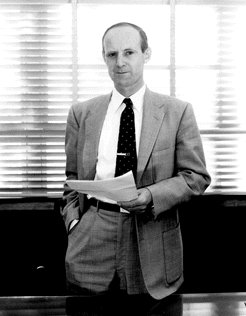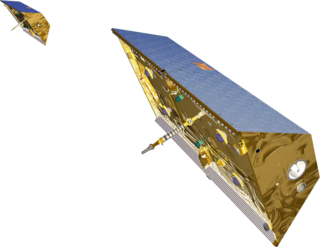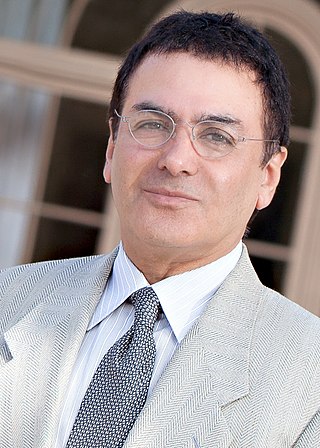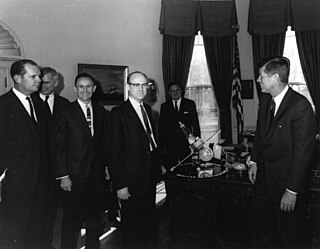
Jet Propulsion Laboratory (JPL) is a federally funded research and development center in Pasadena, California, United States. Founded in 1936 by Caltech researchers, the laboratory is now owned and sponsored by the National Aeronautics and Space Administration (NASA) and administered and managed by the California Institute of Technology.

William Hayward Pickering was a New Zealand-born aerospace engineer who headed Pasadena, California's Jet Propulsion Laboratory (JPL) for 22 years, retiring in 1976. He was a senior NASA luminary and pioneered the exploration of space. Pickering was also a founding member of the United States National Academy of Engineering.

The Gravity Recovery and Climate Experiment (GRACE) was a joint mission of NASA and the German Aerospace Center (DLR). Twin satellites took detailed measurements of Earth's gravity field anomalies from its launch in March 2002 to the end of its science mission in October 2017. The two satellites were sometimes called Tom and Jerry, a nod to the famous cartoon. The GRACE Follow-On (GRACE-FO) is a continuation of the mission on near-identical hardware, launched in May 2018.

Charles Elachi is a Lebanese-American professor (emeritus) of electrical engineering and planetary science at the California Institute of Technology (Caltech). From 2001 to 2016 he was the 8th director of the Jet Propulsion Laboratory and vice president of Caltech.

Firouz Michael Naderi was an Iranian American scientist who spent 36 years in various technical and executive positions at NASA's Jet Propulsion Laboratory (JPL), where he contributed to some of America's robotic space missions.
Kenneth R. Castleman is a retired NASA engineer who now lives in League City, Texas. He holds B.S, M.S. and Ph.D. degrees in electrical engineering from The University of Texas at Austin. He was a Senior Scientist at NASA's Jet Propulsion Laboratory from 1970 through 1985. During that time he headed the Automated Light Microscope project, which paved the way for landing an intelligent microscope on Mars, and he was inducted into the National Space Foundation's Space Technology Hall of Fame. He also served on the faculty at Caltech and on the research staff at USC and at UCLA.

Albert Roach Hibbs was an American mathematician and physicist affiliated with the Jet Propulsion Laboratory (JPL). He was known as "The Voice of JPL" due to his gift for explaining advanced science in simple terms. He helped establish JPL's Space Science Division in 1960 and later served as its first chief. He was the systems designer for Explorer 1, the USA's first satellite, and helped establish the framework for exploration of the Solar System through the 1960s. Hibbs qualified as an astronaut in 1967 and was slated to be a crew member of Apollo 25, but he ultimately did not go to the Moon due to the Apollo program ending after the Apollo 17 mission in 1972.

Bruce Churchill Murray was an American planetary scientist. He was a director of the Jet Propulsion Laboratory (JPL) and co-founder of The Planetary Society.

Donna Lee Shirley is a former manager of Mars Exploration at the NASA Jet Propulsion Laboratory. She is the author of the book Managing Martians: The Extraordinary Story of a Woman's Lifelong Quest to Get to Mars—and of the Team Behind the Space Robot That Has Captured the Imagination of the World.

Edward Carroll Stone is an American space scientist, professor of physics at the California Institute of Technology, and former director of the NASA Jet Propulsion Laboratory (JPL).

Lieutenant General Larry D. James is a former senior officer in the United States Air Force and is currently a civilian NASA administrator. He is the deputy director of NASA's Jet Propulsion Laboratory, where he also acted as the interim director from August 21, 2021 to May 16, 2022. He acts as the Laboratory's Chief Operating Officer responsible to the Director for the day-to-day management of JPL's resources and activities. This includes managing the Laboratory's solar system exploration, Mars, astronomy, physics, Earth science, interplanetary network programs, and all business operations. These activities employ 5000 scientists, engineers, technicians, and business support personnel, generating $1.8 billion in annual revenues. Prior to his current role, he served as the Deputy Chief of Staff for Intelligence, Surveillance and Reconnaissance, Headquarters United States Air Force. James' prior commands included the 14th Air Force and Joint Functional Component Command for Space from Vandenberg Air Force Base in California.

Laurie Leshin is an American scientist and academic administrator serving as the 10th Director of the NASA Jet Propulsion Laboratory and as Vice President and Bren Professor of Geochemistry and Planetary Science at California Institute of Technology. Leshin's research has focused on geochemistry and space science. Leshin previously served as the 16th president of Worcester Polytechnic Institute.

Robert J. "Bob" Parks was a US aerospace engineer and pioneer in the space program where he was intricately involved and/or directed for some of the most historic and important U.S. unmanned space missions. Over a 40-year tenure at the Jet Propulsion Laboratory (JPL/NASA), located in Pasadena, California, Parks’ impact was essential to helping the United States lead the world in space exploration. He served as Guidance Engineer for Explorer 1, the first successfully launched satellite by the United States. He directed the initial flyby missions to the Moon, the first soft landing on the Moon, Earth's first successful mission to another planet and initial missions to Mars, Saturn, Jupiter and Uranus.
Anita Sengupta is an American aerospace engineer. She is a graduate in aerospace and mechanical engineering of the Viterbi School of Engineering at the University of Southern California. She was the lead systems engineer of the team that developed the parachute system that was deployed during the landing of Mars Science Laboratory Curiosity. She was subsequently the project manager of the Cold Atom Laboratory at the Jet Propulsion Laboratory at Caltech. She was then the Senior Vice President of Systems Engineering at Virgin Hyperloop One. She is currently Chief Product Officer at Airspace Experience Technologies (ASX).

David A. Spencer is the Mars Sample Return Campaign Mission Manager at the Jet Propulsion Laboratory. As an aerospace engineer, Spencer designs and operates planetary spacecraft.
George Henry Born was an American aerospace engineer, Distinguished Professor, founder and Director Emeritus of the Colorado Center for Astrodynamics Research (CCAR) at the University of Colorado Boulder. He is known for his work in satellite navigation and precise orbit determination. He worked on various missions while at the Jet Propulsion Laboratory as well as navigation support for the Apollo program in the late 1960s while at Johnson Space Center.
Laura Kerber is an American research scientist at NASA's Jet Propulsion Laboratory studying planetary geology. Her research has covered explosive volcanism, wind erosion in deserts, and extraterrestrial caves. Her work focuses mainly on Mercury, Mars, and the Moon. Kerber graduated from Pomona College in 2006 and holds two master's degrees, in Geology and Engineering, and a PhD in Geology from Brown University.
Moriba Kemessia Jah is an American space scientist and aerospace engineer who describes himself as a "space environmentalist", specializing in orbit determination and prediction, especially as related to space situational awareness and space traffic monitoring. He is currently an associate professor of Aerospace Engineering and Engineering Mechanics at the University of Texas at Austin. Jah previously worked as a spacecraft navigator at the NASA Jet Propulsion Laboratory, where he was a navigator for the Mars Global Surveyor, Mars Odyssey, Mars Express, Mars Exploration Rover, and his last mission was the Mars Reconnaissance Orbiter. He is a Fellow of the American Astronautical Society, the Air Force Research Laboratory, the International Association for the Advancement of Space Safety and, the Royal Astronomical Society. Jah was also selected into the 10th anniversary class of TED Fellows and was named a MacArthur Fellow in 2022. He also was selected into the AIAA class of Fellows and Honorary Fellows in the year of the 50th Anniversary of Apollo 11. The AIAA "confers the distinction of Fellow upon individuals in recognition of their notable and valuable contributions to the arts, sciences or technology of aeronautics and astronautics."

John R. Casani is an American engineer. He worked for the National Aeronautics and Space Administration (NASA) at the Jet Propulsion Laboratory, where he managed the Voyager, Galileo, Cassini and Prometheus projects.

David Y. Oh is an American spacecraft systems engineer and expert in electric propulsion. Dr. Oh currently works at the Jet Propulsion Laboratory (JPL) as the NASA Psyche mission chief engineer. Prior to this role he served as the Project Systems Engineering Manager for Psyche. He was also the cross-cutting phase lead and lead flight director for the NASA Mars Science Laboratory mission and was recognized in popular media for living on Mars time with his family during the month following the landing of the Curiosity rover.















